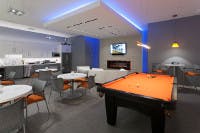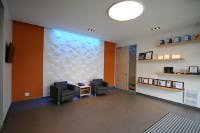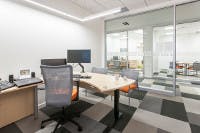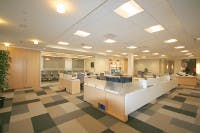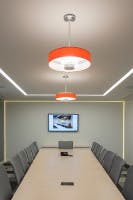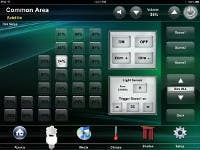This article was published in the Summer 2013 issue of IIF Magazine.
View the Table of Contents and download the PDF file of the complete Summer 2013 issue, or view the E-zine version in your browser.
+++++
Toronto-area lighting representative Salex moved into a new office this past spring, and the move gave the firm the opportunity to demonstrate the broad variety of LED-based lighting products that are now on the market. The team was able to exclusively use LED luminaires indoors and out with the exception of a single fixture. The project included installation of three different adaptive control technologies in various parts of the office, that along with the efficient solid-state lighting (SSL) deliver a typical power density of 0.5W/ft2.
The new Salex facility includes 8000 ft2 of office space and that indoor space is our primary focus here. Salex applications manager Michael Smolyansky said that it's the "only such building in the greater Toronto area" that is essentially all LED lit. The firm represents more than 50 lighting manufacturers and the team working on the new office sought to showcase the many different ways LEDs could be used while still providing pleasing aesthetics and energy efficiency. Smolyansky added, "We are looking forward to not only working in this new building, but educating our clients and suppliers about lighting design as well."
Nick Puopolo, a principal in Salex, said the goal was to use as many different products as possible without the result looking like a showroom. Indeed, each office uses a different set of luminaires while some of the most compelling design work is in common areas such as the lounge, lobby, and boardroom. Puopolo said, "We were trying to show the wide variety of LED products in pendants, downlights, recessed fixtures, and others."
The team also sought to dispel any notion that LED lighting would not work in an office and the result, as you can see in the photos, delivers aesthetically. "This is what an LED office looks like," added Puopolo. "It's not little twinkly lights."
Office lounge
The office lounge (as seen on the cover and frontis above) provides an excellent example of the diversity of products utilized in the project and some interesting architectural work. In the remodel, the team created a dropped ceiling above the couch area of the lounge in front of where the TV is mounted. That dropped ceiling allowed the use of both recessed direct lighting and indirect color-tunable lighting mounted in the cove created above the dropped ceiling.
In the L-shaped recessed channels in the dropped ceiling, the team installed some linear fixtures and some spots. The spots are 3000K Delta Light fixtures that deliver 580 lm. Delta Light LEDSTRIP fixtures provide the direct linear lighting. And SGi Lighting color-tunable LED Flex strips are used in the cove.
The suspended spotlights in pendants used above the tables are also from Delta Light. In the kitchen area, the team used Juno Danalite linear fixtures both under the cabinets for direct light on the counters, and above the cabinets providing indirect light reflected off the ceiling. The fixture above the billiard table is the only non-LED fixture in the office. Puopolo said the team couldn't find a suitable LED product. The Stretto fixture from Molto Luce uses a T5 high-output linear fluorescent tube but is still dimmable.
As we will cover in more detail shortly, much of the office lighting is controllable in various ways including via a DALI (digital addressable lighting interface) network in parts of the office. But the team used a relatively simple control from SGi Lighting for local control of the color-tunable cove fixtures. That decision was intended to make a point. Puopolo said, "You don't have to install expensive controls to implement color-changing lighting." He said the local control panel and cove-mounted controller cost $800. That's far less than what you would spend on a DALI-based control system.
Lobby and office
The team also used color-tunable lighting in the lobby area using Medley fixtures from Insight Lighting. The tunable lighting was used again with a distinctive architectural feature. The room includes what Puopolo calls a feature wall that includes circular patterns that are both concave and convex (see Photo 1). The tunable fixtures are hidden in a cove and cast interesting effects on the textures of the wall. A 3-ft-diameter Delta Supernova luminaire surface mounted on the ceiling provides most of the ambient light in the space.
The individual offices in the building are relatively uniform in shape and size, but the lighting design is unique in each. For example, one of the offices uses Selux M36 linear fixtures in a pendant version (see Photo 2). The fixtures are cascaded, forming an L shape, and provide ambient and task lighting. A series of Delta Tweeter downlights complement the linear lighting.
To light the cubicle workspace in the open office area, the team primarily relied on LRTF LED troffers from Visioneering (see Photo 3). Puopolo said the team chose the basket-style fixtures to get the combination of an indirect effect on the ceiling and optimum direct task lighting. Surface-mount fixtures, recessed linear strips, and downlights complement the troffers around the perimeter of the open area.
The boardroom
Salex's boardroom is the last of the lighting designs that we will discuss before moving on to the controls. The boardroom combines a mix of decorative fixtures, recessed lighting in the ceiling, and wall-mounted linear lighting (see Photo 4).
The prominently placed Borden Lighting Fabric Shade Drum pendants serve more for decorative purposes, according to Puopolo. He said the team utilized the fixtures primarily because products with such a distinctive look are often only offered with legacy sources. But the Borden fixtures are LED based and do provide relatively uniform indirect and direct lighting.
The linear ceiling lighting, oriented as a recessed rectangle that is roughly the size of the conference table, provides the bulk of the lighting in the room. Selux M100 fixtures form the rectangle. And the flangeless design integrates smoothly with the ceiling.
The linear lighting that outlines the wall upon which the presentation monitor is mounted serves to simulate an architectural feature. The surface-mounted Delta Reunion fixtures hide the linear sources inside a frame with a right-angle bend and the light is directed toward the wall. Puopolo said the "LED channel" makes it look like the wall is floating.
Controls
The boardroom also offers a good place to start with the controls angle of the Salex project (see Photo 5). Controls are necessary to maximize energy savings and can also provide a level of luxury. Puopolo said that most office projects use higher-end controls in a space such as the boardroom, and a simpler, less-expensive technology in other spaces. Salex installed a high-end Crestron Electronics system in the boardroom along with two different technologies in the separate private office and open office areas.
The boardroom features a touch-sensitive panel that is capable of controlling the lights in the room individually or based on preset scenes. For example, the ceiling-based fixtures nearest the wall-mounted presentation monitor can be separately dimmed or extinguished during video or slide presentations. The Crestron system can also control the HVAC system, raise or lower the shades, and control the A/V system.
For the open office area, the team specified the Visioneering troffers with a DALI dimming option. Puopolo said that DALI is a relatively expensive choice relative to controlling groups of fixtures with 0–10V controls, for example, but the individual fixture addressability can pay big dividends. A DALI network can still enable logical grouping of fixtures, but those configurations can be easily changed.
Puopolo pointed out, for instance, that individual fixture controls allow building owners the flexibility to reconfigure office space and even add or subtract walls without retrofitting the lighting. He also said that individual control is a requisite for optimum use of daylighting. Salex can program control of the open office lighting using software on a PC, an iPad, or the Crestron control panel in the boardroom that also connects to the DALI network.
The private offices, meanwhile, use the low-voltage WattStopper technology from Legrand. The company calls the system Digital Lighting Management, and within an office sensors, switches or control panels, wall outlets, and light fixtures are connected with RJ-45 cables such as those used for computer networks. Each office is bridged to a BACnet building management network and can be controlled by the building-management software. The implementation allows employees personal control of the lighting in their workspace, and the ability to remotely control the lighting.
Sensing and savings
The various control technologies in the Salex office building all include distributed occupancy sensors that can dim or extinguish lighting in any given area without any assistance from a centralized system. Puopolo said the facility is configured to extinguish lights in any area ten minutes after people leave the area, whether the area in question is a private office or the lounge. He said when the employees leave the office and lock the door at the end of the day, they don't touch light controls. The office simply goes dark in ten minutes.
Dimming is also critical to savings even when employees are present. The only lighting in the indoor space that is not dimmable is the cabinet lighting in the lounge; it is either off or on. The remainder can be incrementally dimmed.
Puopolo said that throughout the office most of the fixtures can deliver 60 fc on a task plane. With the full office lit, and no lights extinguished by occupancy sensors, Puopolo said the installation realizes a power density of 0.75W/ft2.
Rarely are such levels required. Puopolo said the lighting is set to deliver 40 fc when workers are present, noting that all the space is rarely occupied, even if office vacancies are due to a meeting in the boardroom. He noted typical power density during the work day is 0.5W/ft2.
The Salex lighting design clearly exceeds the ASHRAE/IES 90.1 guidelines published in 2010 that are still the most current building codes until January 1, 2014 when the code will be updated. The 2012 standard specifies a maximum power density of 1W/ft2.
What is equally important is that the design met the company's aesthetics goals. Puopolo said, "It had to look like a normal functioning office." As the photos illustrate, the design delivered on that requirement.

